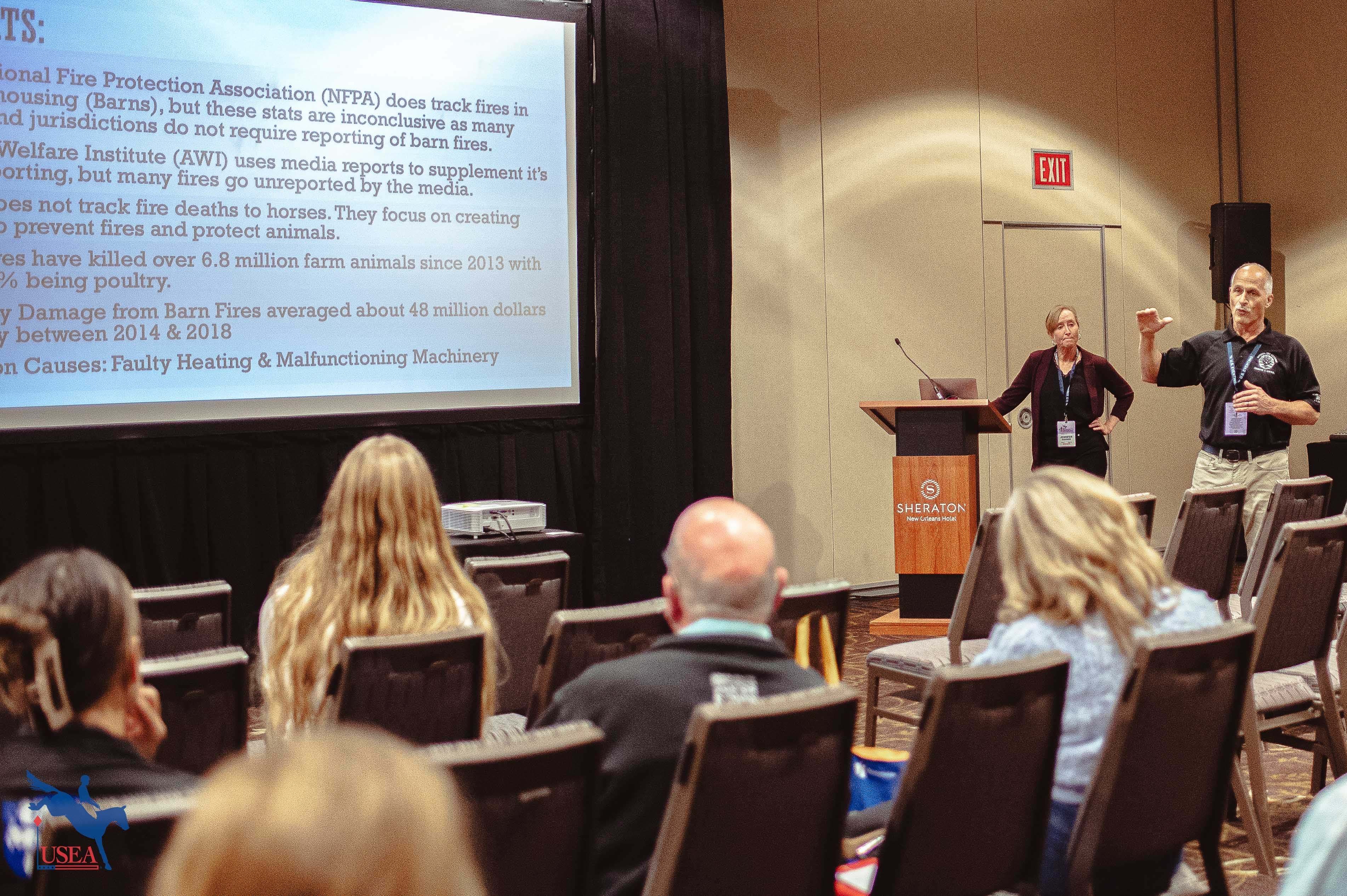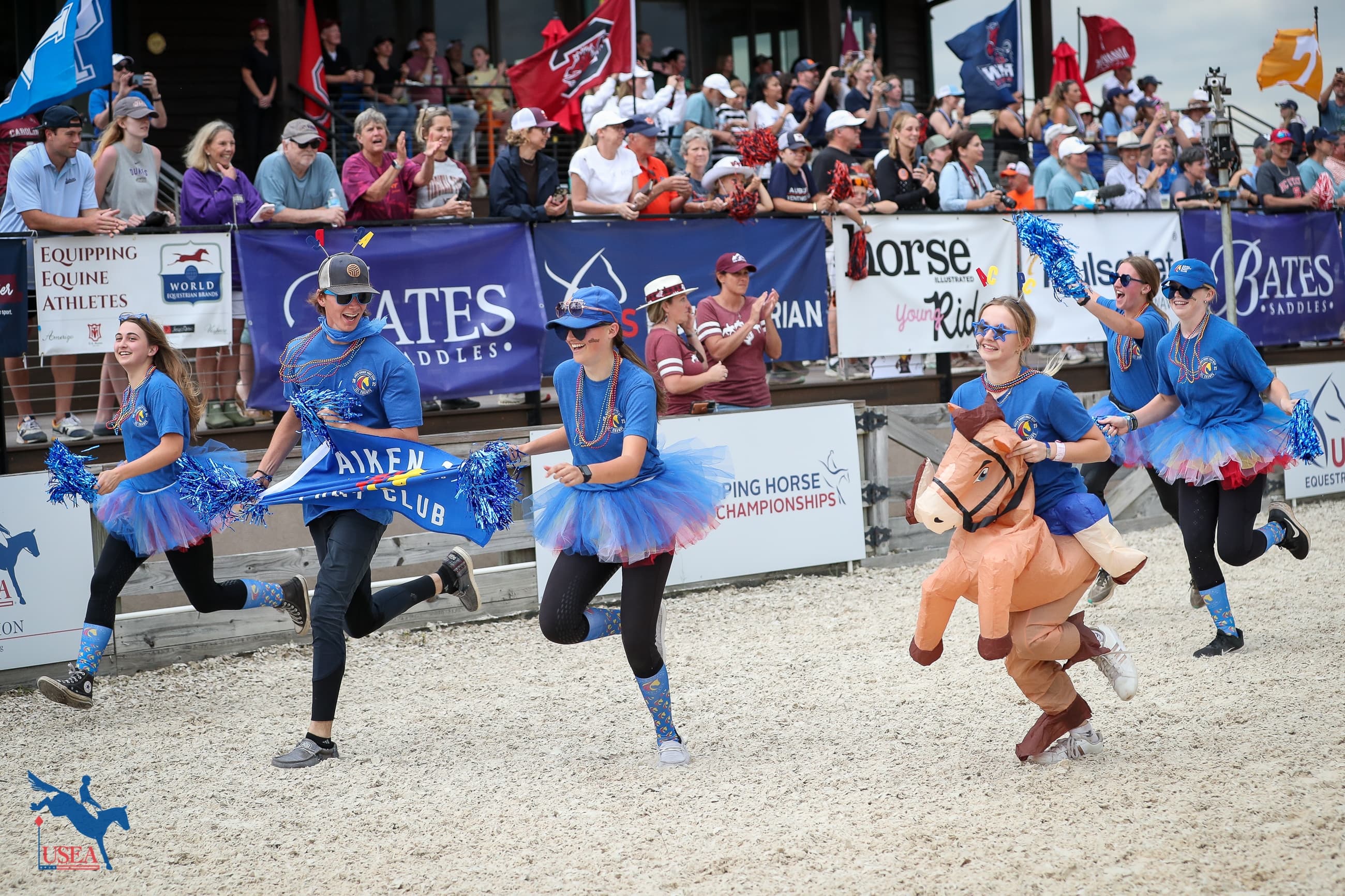Trimming the Fat: Weight Loss Strategies for the Overweight Horse with Dr. Amy Burk

Overconditioned, obese, fat – all these terms can be used to describe an overweight horse. “Equine obesity is a term that we use to describe a horse that has gotten to the point where there’s so much fat accretion on their body that it’s going to cause health problems,” said Dr. Amy Burk, Associate Professor and Coordinator for the Equine Studies Program in the Animal and Avian Sciences Department at the University of Maryland. “This is a topic that I think is an important one to talk about because a lot of horse owners and horse farm managers are dealing with this quite a bit on their farms.”
On average, 30 to 51 percent of the equine population in the United States and abroad can be classified as obese. “What’s scary about that is there are all these health implications for horses, but also that number is somewhat mimicking what we see in the human population,” Burk said. “It’s definitely a welfare concern that we need to address quickly.”
In her virtual presentation on the topic of equine obesity, Burk aimed to teach viewers how to identify overconditioning in the horse, help them understand the implications of obesity for the horse, and learn about a wide range of different strategies for controlling body weight. “All farms are different, all horses are different, the way we manage them is different, and I think that one strategy is not going to work for every horse.”
Identifying Overconditioning in the Horse
The Henneke Body Conditioning Scale, formulated by Dr. Don Henneke in the 1980s, can be used to assess where fat is accruing on the horse’s body. “We’re not assessing how much muscle they have, we want to assess how much fat [they have] because if they have too much fat it means we’re overfeeding them – there’s too much energy there and the horses are storing that energy as fat,” Burk said.
Horses accrue fat on their bodies on their neck, on either side of the withers, behind the shoulder, over the ribs, at the loin, and on either side of the top of the tail. “Dr. Henneke found that if you focus on those areas and assign a score, you’re more likely to assess the fat level of the horse,” said Burk. Henneke’s scale extends from one to nine, with one representing a “poor” body condition and nine representing an “extremely fat” body condition.
“The ideal body condition for most horses is somewhere between four and six,” explained Burk. “Four is ‘moderately thin’ . . . six is ‘[moderately] fleshy,’ but what we don’t want to do is get in the seven, eight, and nine categories because that’s when we know our horses are at a higher risk for metabolic problems including laminitis.”

Typically, one is meant to assess body condition by feeling the fat on the horse’s body, but for the purposes of her presentation, Burk described how different body condition scores present visually. For a body condition score of four, for example, Burk said, “The ridge of the spine and outline of the ribs visible . . . the tail head may or may not be visible depending on the breed . . . withers are prominent and there’s a depression on either side of the withers, not a lot of fat on the shoulder, and the neck doesn’t appear overly thin – you don’t see any fat accruing on the neck on a four. That’s typically the body condition score you’re going to see on an equine athlete – they don’t need to be carrying around 50 to 100 pounds of extra weight.”

“Most horses should be maintained at a body condition score of five,” Burk continued. A body condition score of five should present with spine and ribs that cannot be seen, although the ribs can be felt, there may be a bit of fat accruing at the tail head and behind the shoulder, the hollows on either side of the withers will be filled in, and the neck will have a bit of fat without showing a buildup. Overall, Burk said the horse should have a “smooth” appearance.

For a body condition score of six, fat deposits will have started to appear along the neck, withers, and behind the shoulder, the area over the ribs will feel spongy to the touch, there will be fat around the top of the tail head, and there may be a slight crease along the horse’s spine where fat has built up on either side.

“This is where we don’t want any of our horses to be,” Burk said of the body condition score of seven. A seven will show a definite crease along the spine, filling in of fat along the top of the neck, on either side of the withers, and behind the shoulder, and the tail head will begin to disappear between the fat deposits on either side of the tail. Horses with a body condition score of eight or nine will show increasingly large fat deposits along their topline and sides.
Burk suggests keeping a monthly log of your horse’s body condition score so as to monitor any fluctuations caused by the season or by the horse’s workload and make changes to their diet accordingly. As accurately assessing body condition score can be a tough skill to develop, performing monthly evaluations will give you an opportunity to practice.
Implications of Overweight Horses
From overfeeding of pasture, hay, and grain to lack of exercise and genetic predisposition, Burk asserts that there are several ways that horses can become overweight, despite their owners’ best intentions. The reason it’s such a problem is because of the negative effect obesity has on our horse’s health and performance.
While obvious weight-related health risks like laminitis and equine metabolic syndrome are of concern for overweight horses, other issues like heat stress, poor athletic performance, degenerative joint disorders, and developmental orthopedic disease are other possible negative outcomes due to obesity. Additionally, overweight horses are associated with increased expenses for horse owners - $434 on average, according to a 2018 study performed by Burk and one of her graduate students, Aubrey Jaqueth.
Establishing a Weight Loss Plan
If you have an overweight horse in your barn, the first step towards helping them lose weight is to put together a plan with the help of your veterinarian that takes into account your horse’s specific circumstances and determines the body weight and body condition score that is right for your horse.
On average, one body condition score equates to about 45 pounds and can take anywhere from one to two months to lose. So, if your horse is a body condition score of seven and you are targeting a body condition score of five, your horse will be looking to lose approximately 90 pounds over the course of two to four months.
Evaluating your horse’s current diet and housing situation gives you a place to start when you look at making changes to your horse’s routine. How much time does your horse spend on pasture and what is the quality of his pasture? What quantities of hay and grain is your horse currently consuming? And, how much exercise is your horse currently getting, either under saddle or in turnout?
Weight Control Strategies
Since there is no “one-size-fits-all” solution for equine weight loss, Burk offered up a long list of different strategies horse owners can try until they find one that works for their unique situation. “The three main approaches that we take are reducing calories in the diet (there’s lots of different ways to do that), increasing exercise (easier said than done), and administering medications and supplements.”
“The biggest thing we need to do is reduce calories in the diet, and the main ways we’re going to reduce calories in the diet is to take out the carbohydrates and the fats,” Burk explained. “In the horse industry, we’re very focused on what we call NSC, or nonstructural carbohydrates. Forage has both fibrous carbohydrates and nonstructural carbohydrates, or the sugars and starches, and those are the ones that we’re mainly concerned with.”
The average horse eats 2 to 2.5 percent of their body weight in pounds of feed each day, and some ponies will eat up to 5 percent of their body weight a day. “If you have a 1,100 pound horse, that’s about 20 pounds of forage and maybe a couple of pounds of concentrate,” extrapolated Burk.
To help an overweight horse lose weight, this percentage needs to be decreased to approximately 1.5 percent of their body weight, but it needs to be done slowly. “You don’t want to do it too fast because that can be very harmful to your horse,” Burk said. “You can go as low as 1.3 percent but really you don’t want to go any lower than that.” Reducing feed has its own risks, including colic and gastric ulcers, so it needs to be done carefully and gradually.

When removing portions of a horse’s diet, Burk said the first thing to go should always be concentrate, as that tends to be the most calorically dense part of a horse’s diet. “Those are for exercising horses, young growing horses, or mares in late pregnancy or early lactation – they need more energy in their diets,” Burk said. “Focus on forage . . . the concentrate may only be 1 to 20 percent of the horse’s diet and it’s really the forage that we need to think about first.” A ration balancer can be a good option for continuing to provide vitamins, minerals, and proteins found in concentrate without such a high caloric density.
Limiting the horse’s access to rich pasture grass can be another effective way to reduce caloric intake. By placing your horse on a dry lot, you can more carefully control how much they are eating. However, this solution isn’t without its drawbacks. “They’re stuck in this small lot, they’re not moving like they would be out on pasture. It is an increased cost . . . a lot of times horses start chewing wood fence boards because they’re bored. These areas are highly erodible because of the dirt . . . and it’s tough for weed control.” It can be better, instead, to alternate time with a dry lot or a stall and a pasture to simply reduce their access.

“Grazing muzzles are growing in popularity because it allows your horse to go out and be a foraging horse – they’re walking, they’re eating, they’re interacting with their pasture mates – and they’ve been shown to be extremely effective in limiting the diet,” Burk said. “They can reduce forage intake by 30 to 80 percent in horses and ponies.” There are considerations that go along with using a grazing muzzle, such as how long to leave it on, making sure it doesn’t rub, the possibility of needing to replace it frequently due to wear, and the effect it can have on herd dynamics.
“Another strategy you can try is feeding lower-quality hay,” Burk suggested. Mature hays tend to have lower energy, but they can also be lower in vitamins, minerals, and proteins, so if you choose this route you might select a forage balancer or vitamin-mineral supplement to make sure your horse is still receiving adequate nutrition. If you are interested in learning more about evaluating the quality of your hay, check out this presentation from Dr. Burk.
Similarly, feeding hay that is low in NCS like timothy, orchard grass, bermudagrass, or teff grass is another way to reduce caloric intake. However, the only way to be sure about the composition of the hay you are feeding is to have it tested by a lab. One way to get around that, Burk said, is to soak your hay to reduce the water-soluble carbohydrates like glucose, sucrose, and fructose. “The sugars and starches will become soluble in water so you’re kind of leeching them out of the diet.”
Slow feeders or nibble nets are an option that helps mimic the horse’s traditional grazing style of eating. “Take them back to their roots when they were eating small forage meals over the course of the day,” Burk said. “We’ve domesticated the horse and now we just bring them these large meals – why not make them work for it?”

In addition to decreasing caloric intake, increasing voluntary exercise is an important part of a horse’s weight control program. “Put them in a large pasture if you can – more than two acres,” Burk suggested. “Separate their feed and water so they have to work to get to their feed and then they have to walk to their water and vice versa. You can also add a pasture buddy to encourage play.” Increasing involuntary exercise either with riding under saddle, lunging, hot walker, or even swimming is also helpful.
“There’s really no good research or evidence that shows that medications or supplements reduce the adiposity of horses,” Burk cautioned. Levothyroxine sodium has been demonstrated to induce weight loss and increase insulin sensitivity in healthy horses, but no study has been done on its effectiveness for overweight horses.
“Obesity in horses is a very serious health and welfare problem that we really need to address,” Burk concluded. “There are a lot of negative impacts of obesity on horses including laminitis, reduced performance, and an increased cost to the horse owner. We can reduce weight loss, but we have to change the diet and we have to increase exercise . . . What we really should be focusing on is preventing this from happening instead of treating it when it does happen.”
Want more? Check out Dr. Burk’s full presentation here. Thank you to the University of Maryland Horse Extension program for making this presentation available.
About Dr. Amy Burk
Dr. Amy Burk is an Associate Professor and Coordinator for the Equine Studies Program in the Animal and Avian Sciences Department at the University of Maryland. She teaches courses in equine science and management, oversees the equine breeding program, and advises equine studies undergraduates as well as students in the Maryland Equestrian Club and Eventing Team. She’s given over 100 invited talks on equine nutrition, pasture management, and equine health at the local, regional, and national level. Dr. Burk has received national awards for her work in educating the horse owning public, including Educator of the Year from the Equine Science Society. Dr. Burk is the current Chairman of the Board of the National Association of Equine Affiliated Academics, and is a board member of the Equine Science Society and Maryland Horse Industry. She completed her graduate work in equine nutrition as a Pratt Fellow at Virginia Tech, having earned an MS in 1998 and a PhD in 2001.














